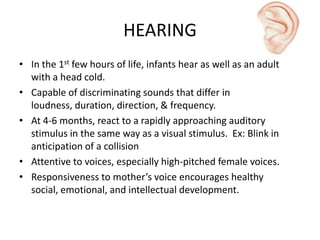
Infant Sensory Development: Hearing, Taste, Smell, Touch, Temperature, Pain, Vision & Intermodal Perception
- 1. HEARING • In the 1st few hours of life, infants hear as well as an adult with a head cold. • Capable of discriminating sounds that differ in loudness, duration, direction, & frequency. • At 4-6 months, react to a rapidly approaching auditory stimulus in the same way as a visual stimulus. Ex: Blink in anticipation of a collision • Attentive to voices, especially high-pitched female voices. • Responsiveness to mother’s voice encourages healthy social, emotional, and intellectual development.
- 2. • Phonemes-Smallest meaningful sound units that make up a spoken language. • Peter Eimas-Research of 2-3 month olds showed they could distinguish consonant sounds that are very familiar, such as ba and pa. • Infants less than a week old distinguish difference between vowels A and I. • By 4-1/2 months, recognition of common words, such as their own name. • By 7-1/2 months, ability to generalize language-learned patterns to other tones, instrument timbres, and animal sounds. • Otitis media- Common bacterial infection of the middle ear that produces mild to moderate hearing loss. -Can cause language development, academic, & social delays. • Sensitive to language properties even when the language is signed rather than spoken.
- 3. TASTE • Infants prefer sweets • Suck faster for sweet liquids than sour, bitter, salty or natural solutions. • Sweets produce smacking of lips and smiles • Sour produces wrinkled nose and pursed lips • Bitter produces expressions of disgust: downturned mouth, tongue protrusions, and spitting.
- 4. SMELL • Infants are capable of detecting a variety of odors. • Turn away and express disgust to unpleasant odors Ex: Vinegar, ammonia, & rotten eggs • 4 days old-Prefer the odor of milk to amniotic fluid • 1-2 weeks – Breast-fed infants already recognize their mothers by the smell of her breasts and underarms and can discriminate between other women.
- 5. TOUCH • Touch and close contact promote developmental progress in all infants. • Lowers stress levels, calms, and promotes neural activity. • Therapeutic effect: Gentle stroking and massaging arouses inattentive infants and calms agitated ones. Causes smiling and bonding with their companions. • Within 1st year babies explore their environment. -First with their lips and mouths -Later with hands -Contributes largely to their early cognitive development
- 6. TEMPERATURE & PAIN • Infants are sensitive to warmth, cold, and changes in temperature. -Refuse to suck milk if it is too hot. -Become more active to maintain body heat if the temperature drops in the room. • 1 day old infants cry loudly & show greater distress when receiving inoculations than 5-11 month- olds. • Males are highly stressed by circumcision -Done without anesthesia , pain-killing drugs risky to give to infants. -High-pitched cries during surgery similar to premature and brain damaged infants.
- 7. VISION • The least mature of a newborn’s senses • Infants more likely to track faces than other patterns. • Neonates have trouble discriminating blues, greens, and yellows from whites. • By 2-3 months, can discriminate all the basic colors. • By 4 months, they can group shades of colors into the same basic categories that adults do. • Visual acuity-A person’s ability to see small objects in fine detail. • Visual contrasts-The amount of light/dark transition in a visual stimulus.
- 8. • Neonates distance vision is about 20/600, which means they see at 20 feet what adults with good vision can see at 600 feet. • The inability to change the shape of the lens of the eye to bring objects into focus makes anything at a distance blurry to an infant. • By 6 months, visual acuity is increased to about 20/100. • By 12 months, they see about as well as an adult. • Newborns can sense movement, colors, changes in brightness, and a variety of visual patterns.
- 9. INTERMODAL PERCEPTION • Intermodal perception-The ability to use one sensory modality to identify a stimulus or pattern of a stimulus that is already familiar through another modality. • Touch and sight are integrated at birth. -Infants expect to touch and feel objects they can see. • Research implies vision and hearing are integrated for infants at about 1-2 months. -Infants expect to hear their mother’s voice coming from the direction of her mouth. • Infants are able to learn face-voice associations of strangers as early as 3-1/2 months.
- 10. • Babies only 1 month old can detect, by sight, some of the same objects they have previously sucked. • By 4 months, infants can match visual and auditory cues for distance. • At 8 months, infants are able to separate object-sound pairings & detect single modality differences. • Multi-modal stimuli promotes perceptual differentiation. • As infants experience multimodal sensory stimuli (using different senses to learn & identify an object) , they develop true intermodal perception. • As they learn to see, hear, smell, taste, and feel, they are able to distinguish & then reintegrate sensory modalities that are becoming more differentiated.
- 11. OVERVIEW Table 5.3 The Newborn’s Sensory Capabilities